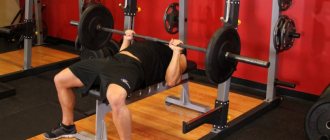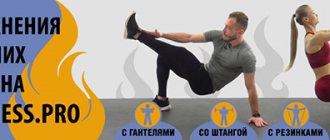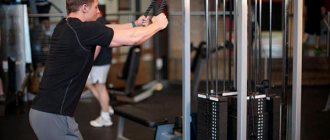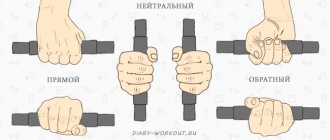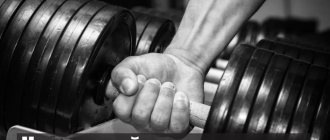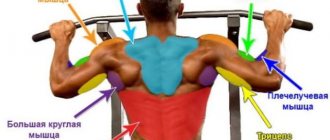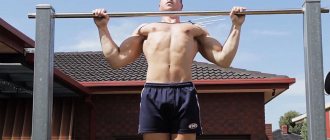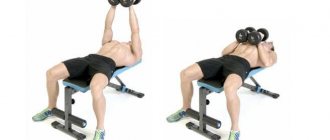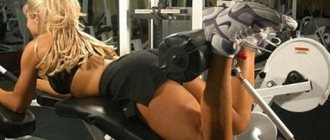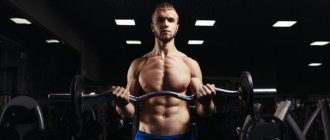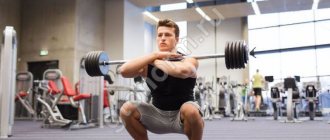Why do the exercise
In bodybuilding, the main movement for working the biceps is considered to be the classic barbell curl. This is completely justified, since the movement is not only mass-forming, but also useful for the development of strength qualities. The reverse grip barbell lift is a variation whose main purpose is to shift the load to those areas that are poorly used in the basic version of the movement.
The main advantages of using a reverse grip:
- Increasing the volume of the biceps (with an emphasis on the outer head).
- Strengthening the muscles and increasing the volume of the forearm.
- Increasing strength in other exercises by strengthening hand strength.
The disadvantages of reverse curls are mainly due to incorrect technique and a lack of understanding of the key features of the exercise. This applies to the weight used, range of motion, tempo and other technical conditions.
Features of arm curls on the lower block with a reverse grip:
- Do not swing your body, thereby helping yourself to bend your arms.
- Lower the handle slowly from the top point. Why is this necessary? The forearm muscles (at the moment, this is our target muscle group) work both in the positive phase (bending the arms at the elbows) and in the negative phase of the exercise (extending the arms, or lowering the handle of the exercise machine down). By going through the negative phase of the exercise slowly, you can feel that the muscles of the forearm are being worked out much better.
- Do not bring your elbows forward when performing arm curls.
- The forearm is a fairly resilient muscle group, so the number of repetitions can be increased to 15-20.
- The arms are always in a pronated position, so the biceps are almost completely excluded from the work.
- The main part of the load goes to the brachioradialis muscle, since it does not perform a twisting function in this exercise.
- This type of flexion works the lateral part of the forearm much better.
Curls strengthen the wrist extensors very well, so the athlete's grip becomes stronger. This is very important if the athlete plans to lift heavy weights in the future. In addition, overhand curls are often included in boxer training to increase punching power.
What muscles work
When working with a reverse grip with a barbell, the main load falls on:
- Biceps brachii muscle.
- Brachialis.
- Brachioradialis muscle.
also as stabilizers when lifting a barbell with a reverse grip:
- Anterior delta.
- Trapezoid (upper and middle parts).
- Wrist flexors.
Execution technique
Technically, the reverse-grip curl is not much different from the regular classic biceps curl, except for the change in the position of the hands and forearms.
Standing technique:
- Take the barbell in your hands with a reverse grip, palms facing you.
- Stand straight with your feet shoulder-width apart. The back is straight, the gaze is directed forward (without skewing the neck forward or backward).
- Slowly lift the bar until your fist is level with your front deltoid.
- Take a short pause and lower the bar to the starting position at a slower pace.
The peculiarity of the movement is that, unlike the classic version with a straight grip, when doing reverse arm bends it is extremely important to fully straighten the arms, that is, the amplitude includes full extension of the elbow. Otherwise, the efficiency of movement will decrease, and the load on the elbow joint will also increase.
Useful tips
1) If your forearms hurt and “break out” during the exercise, take ∑ - a shaped barbell will relieve discomfort;
2) Do not allow your elbows to move too much back and forth from the starting position;
3) Do not lean forward to increase the range of motion and “throw back” the bar;
4) Do not tilt your lower back back while making the exercises easier; the load on the muscle is lost;
5) Do not take too much weight, you will break the technique, less is better and better.
6) Ask your partner to put his hand between your shoulder blades so that you do not deviate during the exercise.
7) If you use a straight bar, your forearms work more; if you use an E-shaped bar, then part of the load flows to the biceps, and the load on the forearms is correspondingly less.
 When lifting the barbell, bring your elbows forward a little, this will allow you to contract your biceps more and load it better;
When lifting the barbell, bring your elbows forward a little, this will allow you to contract your biceps more and load it better;
9) Do not extend your elbows all the way and do not allow them to go back when lowering.
10) Choose a weight at which you can do 8 clean working reps without cheating.
Which neck to choose
- If the athlete has a choice, when lifting the barbell with a reverse grip, you should always give preference to the EZ bar . It is more anatomical and allows you to work more efficiently with the same weight, unlike a straight bar. Also, the curved bar helps reduce stress on the hands, which is especially important when working with heavy weights.
- However, for high rep sets where lighter weights are used, a straight bar . Choose the distance between your hands on the bar so that the wrist twists as little as possible, this will help partially offset the loss of efficiency compared to the EZ bar.
Technique for standing biceps exercises with a barbell
The exercise is performed with a straight bar with a medium grip:
- Standing, feet shoulder-width apart, knees slightly bent (relieve the load from the knees).
- Grasp the bar from below, slightly wider than your shoulders.
- Exhale: bend your arms, lifting the barbell using the efforts of your biceps.
- Inhale: smoothly lower the barbell down.
It is important not to rock your body! To avoid this, you can rest your back against the wall, moving your feet slightly forward. To work with heavy weights, you can slightly tilt your body forward, raising your elbows slightly with the help of deltoids, for maximum contraction of the biceps
To work with heavy weights, you can slightly tilt your body forward, raising your elbows slightly with the help of deltoids, for maximum contraction of the biceps.
Total 4x8-12.
Narrow grip
Works the long head of the biceps, involves bringing the palms closer to each other so that the hands are located on the front surface of the thighs (the joints of the hands are narrower than the shoulder joints).
Common mistakes
Major mistakes that slow down progress or increase the risk of injury:
- Performing the movement at a fast pace. The speed of lifting and lowering the weight with a reverse grip is greater than with a straight grip.
- Using heavy weights – often athletes, especially beginners, chase weight. As a result, when lifting, a large share of the load falls on the shoulders and even the back muscles.
- Incomplete range of motion, which harms the elbow joint and does not provide any benefits.
- When lifting an EZ bar with a reverse grip, a wide hand position (with the thumb pointing down) is used. Holding the barbell with your thumbs down is a mistake that can potentially lead to injury.
Incorrect reverse grip lifting technique
- Body sway and inertia to facilitate movement.
- Raising the bar too high – it is anatomically impossible to bring the bar to the same height as when working with an overhand grip. This is especially evident with large biceps, so you should not try to bring the bar above the “dead point”, this will distort the technique.
Anatomy
Reverse curls develop small muscle groups that are unable to withstand too much load, so in order to achieve hypertrophy of muscle fibers, the load must be limited. At the same time, the load should be accentuated so that stronger muscle groups do not steal it. It should be noted that the forearm consists of two muscle groups, some of which are responsible for supination, others for pronation, therefore, if the forearm is poorly developed, then they should be trained separately, performing flexion or extension of the hand.
Reverse arm curls are only a conditionally basic exercise, so only one joint works, not counting the hand, since this joint is too small. Due to the fact that only one joint works, the entire load falls on it, so the fact that the exercise is performed with light weight does not negate the fact that it must be done with ideal technique. Compliance with the exercise technique in this case is necessary not only in order to achieve the best hypertrophy of muscle fibers, but also in order to keep your elbows in working condition.
Bending your arms at the elbows is the main movement for training the biceps brachii muscle, and when performed with a reverse grip, the load primarily falls on the lower sections of the biceps, the brachialis muscle, and numerous muscles of the anterior surface of the forearm. This exercise is aimed at giving shape to those muscles that are adjacent to the elbow joint, and in most athletes they are less developed than other arm muscles.
Target muscles
B
iceps brachii, brachialis, brachioradialis muscles.
Accessory:
almost all muscles of the anterior surface of the forearm.
Exercise technique
- We lower our shoulders down, pressing our elbows to the body. Work only due to flexion at the elbow joint, all other muscles are fixed.
- We don’t throw the barbell too far up.
- Unlike the standing biceps curl, in this exercise you need to extend your arms completely at the bottom point.
- Exhale with effort, slowly lower.
- The more you use your grip, the more you use the brachioradialis muscle.
Do not train with a barbell that is too heavy, otherwise you will not be able to perform the exercise correctly due to the fact that the weaker shoulder muscle plays the primary role in this version of the arm curl, and the biceps only helps it.
Keep your body straight at all times, do not bend forward. When curling your arms, especially in the last repetitions, do not help yourself with the movement in the lower back. This is “cheating”, which should be avoided if possible, which can be done quite simply by reducing the weight on the bar and keeping your elbows and torso in close contact when performing biceps curls.
Do not allow the hands to bend at different angles at the wrist joint - this can lead to injury, and greatly changes the degree of load distribution between muscle groups towards the forearm muscles.
Video “Barbell Curls for Biceps with a Reverse Grip”
Reverse grip barbell curl
- This is an excellent exercise for pumping not only the biceps, forearms, but also the brachial muscles. If you are doing this exercise for the first time, get ready for new sensations. It will greatly involve the extensor muscles of the forearms (in the picture below they are indicated in red) and, of course, the outer heads of your biceps will be involved in the work.
If you are a beginner and have fairly weak wrists, I recommend performing “reverse grip curls” at the very end of your biceps workout. If you do this exercise at the beginning of your workout, your forearms will tire too quickly, and further biceps work will be less effective.
Many people are accustomed to thinking that reverse grip biceps curls are aimed specifically at working the biceps, and the shoulders are of secondary importance. This is wrong! The exercise is aimed at working the brachialis muscle, which is located under the biceps. It, in turn, helps to push the biceps, and in visual terms, it gives the muscle a more peak state (shape).
If you want to have large and harmoniously developed arms, you simply need to do the “reverse grip curl” exercise. Let's move on to techniques and recommendations.
TECHNIQUES OF PERFORMING THE EXERCISE “BAR BEND WITH REVERSE GRIP”
Technique for performing the exercise “BAR BELL BENDS WITH REVERSE GRIP”
1. Take the barbell with an underhand grip and stand so that your feet are almost shoulder-width apart. The body remains motionless with every up and down movement. Only the biceps and extensor muscles work. This will be your starting position.
2. Great! Now, without moving your elbows, lift the barbell up. To keep the muscles constantly under tension, you should not lift the barbell too high, this will cause the biceps muscles to relax at the top point, and we don’t want that. Remember, in order for the return from any exercise to be as effective as possible, you need to try to constantly keep your muscles tense.
3. Take a short pause at the top, and also smoothly lower the bar to its original position.
4. For an example of performing the exercise “Reverse Grip Barbell Curls,” see the training video:
TIPS ON EXERCISE TECHNIQUES
1. When lifting the barbell to the top point, you cannot help push it up with your body or hips. You cannot use inertial force in this exercise. The body should always be in a vertical position relative to the floor. Only the biceps and forearm muscles work.
2. Don't take too much weight. It is better to take less weight and do the exercise correctly than to take heavy weights and perform the exercise without following the correct technique. If you don't do the exercises correctly, it will lose its effectiveness.
3. When lifting, you can move your elbows forward a little to increase contraction of the biceps muscles. But don’t put your elbows out too far; by helping the muscles, you again reduce the load on the biceps.
How to include in training
Basic rules for introducing movement into the training process:
- Despite the different directions, it is better to alternate presses with direct and reverse grips, performing them on different training days. This will allow you not to exceed the permissible training volumes and pump all the muscles.
- Alternate working with barbells and dumbbells for weeks. Changing the equipment will allow you to add variety to the training process.
- Perform 3-4 sets per workout, it is recommended to do the last set on failure.
- In the strength version, it is optimal to do 8-12 repetitions, in the multi-repetition version - from 12 to 20, depending on the weights used and the level of physical fitness.
- The movement can be performed either at the beginning or at the end of the workout, but only after a thorough warm-up.
